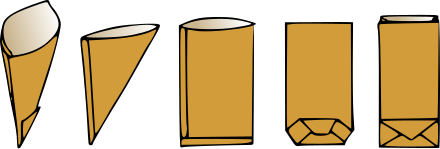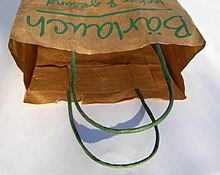bag
In Germany, bags generally refer to deformable transport containers of different sizes and shapes made of paper , plastic or other flexible materials for holding food, loose smaller objects, powdery materials or a complete purchase when buying in supermarkets and specialty shops. Over the past 200 years there has been an expansion of what is referred to by the term. While at first it almost exclusively referred to conical bags in the shape of a funnel, the term also includes plastic carrier bags ( plastic bags ), for example . Until the 20th century, the cone was one of the most important utensils in retail . As a result, the distinction between the terms bag and pouch has become blurred.
In old Bavaria and Austria, the term Sackerl is common. Small funnel-shaped containers made of paper are called Stanitzel (except for Western Austria) . As in Germany, larger containers are referred to as sacks .
etymology
The word is derived from the Middle Low German tute (for " horn "), which used to mean exclusively "funnel-shaped" (also as a wind instrument, compare "to tute into the same horn ").
history
Initially, the term cone cones was meant. One can only speculate about the origin of these bags. Since cone bags can be made from large leaves or skins without tools, they are probably among the oldest containers of all. The first literary references to bags (for spices) come from the 1st century AD. Paper has been produced in Germany since around 1400 and the paper bag comes into use. In the dictionary of Erasmus Alberus of 1550 the term “Dott” is added and in 1555 a polemic pamphlet contains: “Even if the Holy Scriptures are nowhere to be used, they are good for being written on them from the pages, Teutichen make and pepper or other seasoning in it. ”In the picture“ Children's Games ”by Pieter Bruegel the Elder . Ä. A bag made of printed paper is shown from the same period.
19th century
The world's first factory for the production of paper cone bags was built on August 18, 1853 in Bad Sooden-Allendorf, Hesse . Rectangular shapes with flat bottoms could only be made by machine since the construction of the block bottom bag machine in 1901 and, in the absence of a name of their own, were also referred to as bags in large areas of the German-speaking area. It was not the shape but the function that was essential. Since 1908, cellophane was (brand name "cellophane") invented, came to the opaque paper bags should also clear transparency bags, in which the content can be seen immediately.
20th century
Until the middle of the 20th century, everyday goods were largely offered loose in retail and the traders counted or weighed the desired quantities in order to bag them individually for the customer . With the advent of self-service , all products are increasingly being packaged by the manufacturer in a more or less complex manner and the traditional bag has been replaced by the plastic tear-open bag, welded on both sides, apart from the few exceptions such as in haberdashery and the sale of sweets at kiosks. In snack bars, French fries were still sold in cone bags made of parchment paper, similar to the way fish and chips are still used in England.
At the beginning of the 20th century, a special form of the no longer funnel-shaped bag appeared. The carrier bag is a large block-bottom bag made of strong paper with handles, a disposable product as a replacement for a shopping bag or basket, which also served as an advertising medium. Without handles, it is still the usual packaging for everyday shopping in the USA . In Europe, it has been largely replaced by the plastic carrier bag made of polyethylene since the 1960s (market share around 1970: around two thirds).
At the beginning of the 21st century, almost 100 billion plastic bags were put into circulation in Europe. Studies have shown that this corresponds to 198 bags per year and citizen, almost all of which were single-use bags. In order to reduce the risk to humans and animals on land and in the oceans from plastic waste, the Council of the European Union has decided to reduce the consumption of plastic bags. This EU directive came into force on October 1, 2015, and the consumption of 76 plastic bags per German citizen is to be reduced to 40 per inhabitant by 2025. As an environmentally friendly alternative, the paper bag or paper bag has since experienced a renaissance.
Special bags
Because of their shape reminiscent of a pointed bag, the following objects are also referred to as bags, even if the material or function of the above Definition differ:
- a school cone , a rigid container in the form of a cone
- an ice cream cone , a hollow waffle in the shape of a cone , albeit rigid
- a joint
Similar containers
A sack is generally used to refer to larger bags or cloth bags, especially for bulk goods (e.g. flour or charcoal for grilling). The term bag can be used as a generic term and synonym for bags and sacks (such as garbage bags ). Smaller sacks, especially those made of fabric or leather, are often referred to as bags (such as wallets ).
literature
- Heinz Schmidt-Bachem : Bags, pouches, carrier bags. On the history of the paper, cardboard and foil processing industry in Germany . Munster 2001.
Web links
Individual evidence
- ↑ Ulrich Ammon, Rhea Kyvelos: variant dictionary of the German: the default language in Austria, Switzerland and Germany as well as in Liechtenstein, Luxembourg, eastern Belgium and South Tyrol . Publisher Walter de Gruyter, Berlin 2004.
- ^ Heinz Schmidt-Bachem: Bags, pouches, carrier bags . Waxmann Verlag, Münster 2001, ISBN 3-8309-1037-1 , p. 51-52 .
- ↑ sp: Art on the bag. Retrieved March 12, 2018 .
- ↑ saw: EU Parliament adopts anti-plastic bag directive. April 28, 2015, accessed March 12, 2018 .
- ↑ The fabric bag fashion trend - the marsupials. March 4, 2010, accessed March 12, 2018 .



